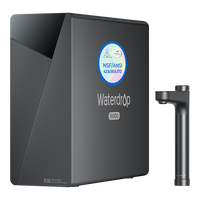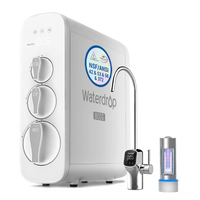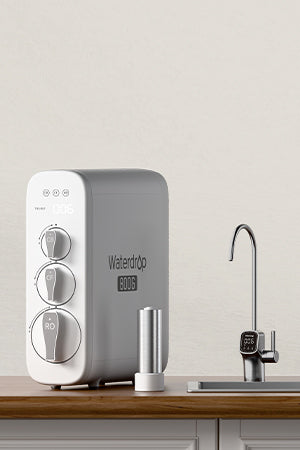PFAS or Per- and Polyfluoroalkyl substances are a group of artificial
chemicals used extensively in producing different consumer and industrial products. Since the 1940s,
manufacturers have leveraged the grease and water-resistant properties of these chemicals in the production of
non-stick cookware, waterproof clothing, stain-resistant fabrics, firefighting foams, food packaging, and more.
PFAS are also popular for their capability to last long in the environment. They
are not broken down by natural processes, which explains why they are called “
forever chemicals.” Their longevity also means they can persist in water,
soil, and even the bodies of humans and animals for years. The increasing persistence and application of PFAS
also come with the risk of possible adverse effects on the environment and human health.
What Are the Health Risks Associated with PFAS Exposure?
PFAS in the human body can illicit many significant health risks. For example,
drinking water contaminated by PFAS or “forever chemicals” accumulates these chemicals in the body over time,
which may affect the body negatively.
Here are some of the health risks associated with PFAS exposure;
Exposure of Organs to Risk
Exposing the body to PFAS-contaminated water for a long time often puts organs in
the body at varying degrees of risk. Organs usually affected include the liver, thyroid, and the overall immune
system. The exposure is also a common precursor to certain cancers, including testicular and kidney cancers.
Reproductive and Developmental Deficiencies
Exposing a pregnant woman to PFAS can affect fetal development adversely, with
particular impacts on the development of the immune system, developmental milestones, and birth weight. In
addition, exposure to PFAS can also alter reproductive health negatively, translating to hormonal regulation and
fertility problems.
Endocrine Disruption
Studies have shown that PFAS interfere with the smooth operation of the endocrine
system, which is responsible for hormonal regulation in the human body. The disruption in operation can cause
hormonal imbalances, thus adversely impacting essential bodily functions like growth and metabolism.
Impact on Children
Children are also vulnerable to the health risks associated with exposure to PFAS.
The young developing bodies of children tend to be less tolerant to the accumulation of these chemicals.
Therefore, even minimal impacts can have long-lasting and extensive adverse effects on their well-being.
Immune System Suppression
The immune system gets weak due to prolonged exposure to PFAS-contaminated water.
The accumulation reduces the natural ability of the body to fight diseases and infections, putting such
individuals at a greater risk of illnesses.
Considering the possible health risks involved with exposure to PFAS-contaminated
water, homeowners must strive to put measures in place to protect their drinking water and, in turn, their
families. These include testing and monitoring water regularly and adopting suitable water filtration systems.
Can PFAS Be Removed from Water Through Filtration?
Yes, water filtration can get rid of PFAS in water. Studies have shown different
filtration methods to reduce PFAs to safe levels in water effectively.
Activated carbon filtration is one of the most commonly used techniques to remove
PFAS from water. The porous structure of activated carbon traps and adsorbs PFAS molecules, effectively reducing
their presence in the water.
Another effective filtration method is
reverse osmosis, which uses a semipermeable membrane to separate contaminants
from water. Reverse osmosis has demonstrated high efficiency in removing PFAS, making it an excellent choice for
treating water contaminated with these chemicals.
Homeowners can also consider ion exchange resins and granular activated carbon as
filtration options to combat PFAS contamination. These techniques can remove specific PFAS compounds, offering a
more streamlined and effective treatment.
Although filtration has been established to reduce PFAS levels significantly in
water, it is essential to maintain and monitor the filtration systems closely to ensure they remain effective
over time. PFAS treatment technologies will continue to evolve based on the increasing understanding of these
chemicals and how they work. Therefore, homeowners can rest assured that they will always find an effective way
to provide safer drinking water for their households.
How Effective Are Waterdrop Filters in Removing PFAS?
An effective way of ensuring that your drinking water does not contain harmful
contaminants is to filter it directly from the source. Some Waterdrop filtration systems can ensure your water
is filtered and the PFAS reduced before consumption.
PFOA and PFOS are two of the PFAS substances which are relatively more widely used
compared to others. The public has a higher level of concern regarding these two chemicals, and testing
primarily focuses on PFOA and PFOS. You can click
here to check the full report.
Waterdrop G3P600 Tankless Reverse Osmosis System
The 600 GPD RO system has an NSF/ANSI 372 certification for containing lead-free
materials and an NSF/ANSI 58 for TDS reduction. Besides, this system is able to effectively reduces the amount
and concentration of harmful substances like PFAS, carbofuran, alachlor, and chloroform in the water to
permissible limits as specified in NSF standards. This ensures that the water you drink is safe and healthy.
Waterdrop G3P800 Tankless Reverse Osmosis System
If you have a big family, Waterdrop’s G3P800 under-sink RO system could be your
best choice. It is an impressive unit boasting a remarkable daily capacity of 800 gallons. This high-performance
system holds several prestigious certifications, such as NSF/ANSI Standard 58, ensuring effective TDS reduction,
and NSF 372 certification, guaranteeing the use of lead-free materials.
Waterdrop K6 RO Instant Hot Water Dispenser
The Waterdrop K6 offers advanced multistage filtration with a 5-in-1 efficient
filter unit, ensuring the reduction of various contaminants. Its user-friendly smart display faucet provides
real-time information, while the step-less temperature change feature allows for filtered hot water on demand
(104℉ to 203℉). With best-in-class safety measures, including internal water purification monitoring, Child
Lock, and overheating protection, the K6 guarantees purified and safe hot water for various uses.
Waterdrop A1 Reverse Osmosis Water Dispenser
Introducing the All-in-One Water Dispenser, an ideal solution for families seeking
easy access to water at various temperatures. This dispenser is certified lead-free and has passed the SGS
testing. Its 6-stage filtration includes a highly efficient RO membrane, UV-LED sterilization, and removal of
over 1,000 impurities.
The flexible temperature options range from 41℉ to 203℉, catering to various
preferences. The OLED Smart Display shows water quality, volume, temperature, and filter life, with
user-friendly features like night mode. Installation is simple, with no drilling or plumbing required. Safety
features include a child lock and temperature indication lights.
To Wrap Up
The widespread contamination of these harmful substances is a pressing concern that
demands immediate attention. Understanding the impact of PFAS and the significance of consuming clean water is
crucial for safeguarding your health. By being aware of PFAS’s impact and taking proactive measures to invest in
the right water filtration system, you can minimize exposure risks and protect your family from the so-called
“forever chemicals”.














































































